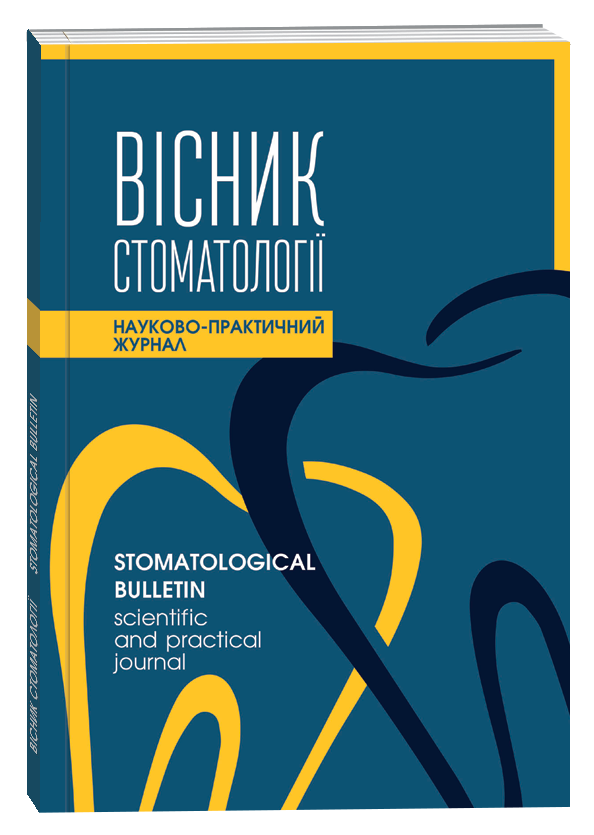COMPARATIVE ANALYSIS OF THE DENSITY OF THE CORTICAL LAYER OF BONE TISSUE OF THE PROCESSES AND THE ANGLE OF THE MANDIBLE IN ACQUIRED DENTITION DEFECTS
DOI:
https://doi.org/10.35220/2078-8916-2023-50-4.10Keywords:
bone atrophy, mandibular processes, computer tomography.Abstract
Purpose of the study. To conduct a comparative analysis of the density of the cortical layer of the bone tissue of the processes and the angle of the mandible in acquired dentition defects to identify their average parameters according to age periods and study groups. Research methods. The study involved 136 (one hundred and thirty-six) computed tomographic cone (9 X 16) scans of the human face as objects of study, corresponding to two periods of adulthood of postnatal ontogeny (I period of adulthood – men 22-35 years old, women 21-35 years old; II period – men 36-60 years old, women 36-55 years old) and assigned to three groups, depending on the distribution of the dentition defect in the lateral parts of the mandible. The subject of the study is the density of bone tissue within the cortical plate at the top of the articular and coronoid heads, as well as the areas of the mandibular angle that were primarily subjected to remodeling processes or pathological changes. Statistical analysis is interpreted in qualitative and quantitative terms, using non-parametric evaluation criteria as mean (M) and standard deviation (±σ). Scientific novelty. The average values of the studied quadrant of the articular process head, which is the target and priority object that is primarily exposed to pathoetiologic factors, are M = 1165 conventional gray units (CGU) on the right side in the first age period of postnatal ontogeny, where = σ ±318,2 and M = 1074 CGU, where ±280,9 on the left side. In the second age period of postnatal ontogeny, M = 1123 CGU, where σ = ±270,9 on the right side and M = 995,0 CGU, where ±201,8 on the left side, under the influence of acquired factors that stimulate the activity of remodeling processes. Conclusions. The change in the density of the cortical layer of the bone tissue of the mandibular processes is synchronous with the change in the density of the cortical layer of its angle, as the main stable structural, morphological barrier in the case of loss of the masticatory group of teeth.
References
A retrospective cephalometric study on the craniofacial morphology of adult patients with unoperated submucous cleft palate / Zh. Chen et al. Journal of Cranio-Maxillofacial Surgery. 2023 November. Vol. 51, № 11. P. 702–707. DOI: https://doi.org/10.1016/j.jcms.2023.08.005.
The correction of asymmetry using computer planned distraction osteogenesis versus conventional planned extraoral distraction osteogenesis: A randomized control clinical trial / Ya.N. El Hadidi et al. Journal of Cranio-Maxillofacial Surgery. 2022 June. Vol. 50, № 6. Р. 504–514. DOI: https://doi.org/10.1016/j.jcms.2022.04.002.
Ошурко А.П. Результати денситометричної оцінки при атрофії кісткової тканини нижньої щелепи, з лівої сторони. Вісник проблем біології і тмедицини. 2022. № 1(163). С. 235–240. DOI: https://doi.org/10.29254/2077-4214-2022-1-163-235-240.
Значення морфометричного дослідження для визначення мінливості топографічних співвідношень структур нижньої щелепи на прикладі сагітального зрізу її кута / А.П. Ошурко та ін. Клінічна та експериментальна патологія. 2021. Т. 20, № 4. С. 58–65. DOI:
https://doi.org/10.24061/1727-4338.XX.4.78.2021.7.
Kaban L.B., Posnick J.C. To Save or Resect a Remodeled Condyle in Young Patients? Journal of Oral and Maxillofacial Surgery. 2023. Vol. 81, № 11. P. 1323–1324. DOI: https://doi.org/10.1016/j.joms.2023.07.139. ISSN 0278-2391.
Condylar resorption post mandibular distraction osteogenesis in craniofacial microsomia: A retrospective study / Kai-yi Shu et al. Journal of Cranio-Maxillofacial Surgery. 2023 November. Vol. 51, № 11. P. 675–681. DOI: https://doi.org/10.1016/j.jcms.2023.10.001.
McLeod N.M.H., Saeed N.R., Gerber B. Remodelling of mandibular condylar head after fixation of fractures with ultrasound activated resorbable pins: A retrospective case series. Journal of Cranio-Maxillofacial Surgery. 2023. Vol. 51, № 7–8. P. 460–466. DOI: https://doi.org/10.1016/j.jcms.2023.07.004.
Lai B.R., Liao H.T. The Comparison of Functional Outcomes in Patients With Unilateral or Bilateral Intracapsular Mandibular Condylar Fractures After Closed or Open Treatment: A 10-Year Retrospective Study. Ann. Plast. Surg. 2023 Apr 1. Vol. 90 (1 Suppl. 1). S19–S25. DOI: 10.1097/SAP.0000000000003346. PMID: 37075291.
Evaluation and Prediction of Healing Morphology After Closed Reduction for Unilateral Mandibular Condyle Fractures / S. Abe et al. J. Craniofac. Surg. 2023 May 1. Vol. 34, № 3. Р. 865–869. DOI: 10.1097/SCS.0000000000008978. PMID: 36036502.
3-Dimensional Morphometric Outcomes After Endoscopic Strip Craniectomy for Unicoronal Synostosis / A. Elawadly et al. J. Craniofac. Surg. 2023 Jan-Feb 01. Vol. 34, № 1. Р. 322–331. DOI: 10.1097/SCS.0000000000009010. PMID: 36184769.
Quantification of Severity of Unilateral Coronal Synostosis / S.A.J. Kronig et al. Cleft Palate Craniofac. J. 2021 Jul. Vol. 58, № 7. Р. 832–837. DOI: 10.1177/1055665620965099. Epub 2020 Oct 20. PMID: 33078622; PMCID: PMC8209757.
Morphologic changes in idiopathic condylar resorption with different degrees of bone loss / Yifan He et al. Oral Surgery, Oral Medicine, Oral Pathology and Oral Radiology. 2019 Jun. Vol. 128, № 3. P. 332–340. DOI: https://doi.org/10.1016/ j.oooo.2019.05.013.
Ji Y.D., Resnick C.M., Peacock Z.S. Idiopathic condylar resorption: A systematic review of etiology and management. Oral Surg Oral Med Oral Pathol Oral Radiol. 2020 Dec. Vol. 130, № 6. Р. 632–639. DOI: 10.1016/j.oooo.2020.07.008. Epub 2020 Jul 21. PMID: 32807713.









